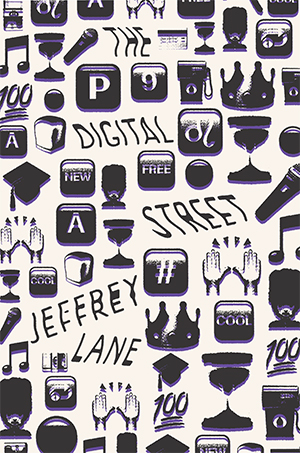
Update August, 2019
The American Sociological Association's section titled Communication, Information Technologies, and Media Sociology (CITAMS) named "The Digital Street" Best Book Award Co-Winner at the ASA Annual Meeting held from August 10-13, 2019 in New York City. Committee Comments: "Richly researched and compellingly told, we commend The Digital Street for its methodological rigor, for bringing CITAMS scholarship into respectful dialog with other traditions of sociological inquiry, and for shining light on how social media are being woven into the daily lives of some of the most vulnerable members of society. Centered on a lengthy ethnographic engagement with a group of young people growing up in Harlem, the book not only complicates well-received accounts of the digital lives of contemporary U.S. youth, it also draws much needed attention to the hopeful and concerning ways in which new media technologies are being incorporated into efforts to shepherd and police young people who are coming of age in conditions of racialized urban poverty."
Update June 19, 2019:
"The Digital Street" has won the Nancy Baym Book Award from the Association of Internet Researchers (AoIR), who wrote about the award: "'The Digital Street' is a compelling ethnography of the interconnecting codes of disadvantaged girls and boys on the streets of Harlem and digital media. He shows the overlaps, disconnects, and, perhaps most importantly, the opportunities social media may offer for intervening in youth violence. Its combination of urban ethnography with the digital provides a model both for ethnographers unused to considering the digital, and for digital ethnographers less versed in urban approaches. Read more about it here."
Update June 7, 2019:
"The Digital Street" has been named the co-winner of the 2019 CITAMS Book Award. CITAMS is the Communication, Information Technologies, and Media Sociology section of the American Sociological Association. Lane will receive the award at the ASA annual meeting which will be held in New York in August.
Although he didn’t know it at the time, Rutgers School of Communication and Information (SC&I)'s Assistant Professor Jeffrey Lane began the research for what would eventually become his new book back in 2009, when he was a doctoral student in search of a topic for his dissertation. The origins of his book “The Digital Street,” published in 2018 by Oxford University Press, initially grew out of Lane’s chance meeting with a local pastor.
In 2009, Lane and his soon-to-be wife were living in a brownstone unit in Harlem while he was a graduate student in the sociology department at Princeton University and she was a graduate student at Columbia University.

Lane traces the beginning of the book to a community event where he met a man who was known in the neighborhood as Pastor. When Pastor asked for volunteers to help him try to track, prevent and reduce incidents of teenage violence in the neighborhood by using social media, Lane volunteered.
By joining Pastor’s peace ministry, Lane soon met hundreds of teenagers and the people who cared for them, and began to take his own service roles in ways as diverse as getting involved to prevent or diffuse conflicts, playing basketball, and setting up a computer lab for youth and seniors with donated computer equipment.
As a result, Lane saw first-hand how smartphones and social media were drastically changing ways teenagers were communicating and managing every aspect of their lives. He also observed that their parents, mentors, and other neighborhood adults in their lives in addition to police, were also using it to stay informed about them, and even take action against them. Lane realized they were all living in parallel worlds on two streets: the physical streets in their neighborhood, and “the digital street” the technology opened the doors to.
Lane realized what he was witnessing was a new and unstudied phenomenon, and decided to focus the subject of his doctoral dissertation on the digitization of a neighborhood and the role of the internet in local street life. After he joined the faculty at SC&I, he expanded his dissertation into a book.
“I didn’t intend to study digital communication,” Lane said. “I was trained as an urban ethnographer, but it quickly became clear that the teenagers I was getting to know as an outreach worker were all connected to each other online, and had been for years, and whatever they were going through in the neighborhood they were experiencing digitally as well—friendships and dating, school and finding work, watching their back, etc.
“It’s the first book about the digital life of a neighborhood that I know of,” Lane said. “The book is based on studying the same people and events as they move between the streets and social media. It’s also the first book to show how the digital life of a neighborhood specifically impacts black teenagers.”
As Lane explains on page four of “The Digital Street,” “Communication scholars have embraced neighborhood effects studies, but most urban research excludes media, information, and communication processes by looking for other mediating variables or mediated efforts to explain social order. I hope to bridge and expand both the communication and urban fields by grounding the study of digital media in the people, processes and craft of urban ethnography.”
Tracing the ways social media evolved as a way to track the behavior and locations of teenagers involved in neighborhood violence, Lane said, “In Harlem and NYC the proliferation of social media especially in the last ten to twelve years has coincided with the suppression of youth gangs. New York was already at the height of crime control before social media and with the added visibility of these platforms, police and prosecutors have much wider access to evidence and still more tools for the surveillance, investigation, and prosecution of gang crime. But the law enforcement side is only part of the story of declining violence. Young black and Latino people in the grips of gun violence are multifaceted and the teens I studied wanted far more than respect on the street—they were focused on work, education, art, family, and other areas of life for which they publicized and supported one another on social media and in person. I didn’t see upward mobility but I saw teenagers searching for stability by their late adolescent years and working in retail, service, construction, and so-called gig-economy jobs.”
Lane explained that digitization is being used as a means to “anticipate and control violence, in Harlem and beyond.” Lane said, “Young people involved in violence telegraph their moves on social media. They make threats online. They usually didn’t just go do violence, which is an emotionally strenuous and awful thing to do. The kind of violence they’re in isn’t about drug business—it’s performative and expressive and capitalizes on the publicity and multimedia of the internet. Young people inside these encounters and concerned adults can see and respond to physical violence before, during, and after it happens. Conflicts move between the physical and digital streets of the neighborhood and that can be a resource for understanding and controlling it.”
Whether the police view the digitization of “the street” as an improvement in terms of their ability to police, was also an area Lane studied. There is always a chance that when law enforcement monitors teenagers (or any subject) by using social media it can result in misunderstandings and misinterpretations that could lead to false accusations and or false arrests. Lane said, “Police may talk about the worsening of violence with social media, but they use it to gain tremendous access to people and events in the neighborhoods they police. Police and prosecutors need to be very careful with social media because it makes all kinds of associations between people in the same neighborhood visible and much of social media is about posturing and strategic communication. Social media should not be taken at face value. I certainly saw police overreach and misinterpret digital content. I also saw police and prosecutors with so much intelligence on top of what they gathered through social media that they were able to identify and prosecute those handling and firing guns in the community.”
Lane explained that the overlapping realities of the digital and physical streets have changed the way teenagers interact with each other, which has wide-ranging implications. “The street’s different now, Lane said. “When girls and boys pass each other, they’ve already studied each other’s profiles and maybe even interacted online. There are more lines and layers of communication so teens have new ways to manage and pace their relationships. I think this gives teenagers more control of street life, at least it did for the teens I studied. Of course, factors like family support, racial discrimination, and access to jobs shape the safety and risk-taking behavior of young people in poverty, and I think Harlem has more hope and resources than other racially segregated urban areas where social media has become a basic fact of life.”
pass each other, they’ve already studied each other’s profiles and maybe even interacted online. There are more lines and layers of communication so teens have new ways to manage and pace their relationships. I think this gives teenagers more control of street life, at least it did for the teens I studied. Of course, factors like family support, racial discrimination, and access to jobs shape the safety and risk-taking behavior of young people in poverty, and I think Harlem has more hope and resources than other racially segregated urban areas where social media has become a basic fact of life.”
In terms of how the teenagers he studied view the impact of social media on their lives, Lane said they “see the promises and pitfalls of social media and smartphone first hand. As black teenagers dealing with neighborhood violence and poverty and the suspicion of police, they use these technologies to give and get social support and to manage the risks and opportunities around them. And they see their digital data and traces used to be both help and punish them.”
Social media and smartphones have also drastically changed the ways parents, outreach workers, and other adults understand what is going on in the lives of the teenagers in their lives. Lane said, “Parents and neighborhood adults have access to the test moments and turning points in the lives of the adolescents under their care. Teens, of course, need and deserve their privacy, but when you’re talking about teens in street-corner groups and neighborhood violence, the more caring adults with resources that are present in their on- and offline lives the better.”
Lane stresses that the students use social media and their smartphones to achieve their goals as students and athletes as well. “These technologies touch all aspects of life, Lane said. “In terms of school, it’s important to make clear that the street-involved black and Latino teens I studied made major use of Job Corps, Harlem Children’s Zone, the community college system, and the various scholastic and employment resources and opportunities available to them. They did not conceal these efforts or denigrate others in their pursuit of education and work. On the contrary, they posted photos of acceptance letters to college, letters of hire, high marks on schoolwork, honor roll certificates, etc. and they supported each other socially and emotionally and shared practical advice to help one another succeed. They did not see themselves as outside of society or hopeless even when labeled as gang members and involved in gun violence.”
Asked what advice Lane would offer future ethnographers interested in doing this type of work, Lane said, “Start from relationships in person that are based on face-to-face trust and accountability; then extend these online. Don’t allow either face-to-face or digital modes of knowledge to outpace or stand in for the other. The best and richest fieldwork connects online to offline life, traces situations between both forms of engagement, and can even explain why people communicate in one location or the other.”
In addition, he added, “Girls are the central and most important components of neighborhood networks. Their networks are much broader and they broker opportunities for themselves and the boys around them. Girls are positioned as peer leaders and we should empower them.”
Lane said while at SC&I working on the book, he was encouraged and supported by the deans and his senior colleagues to write the book, and “to research and teach an agenda around it, which incorporates urban inequality and sociology, communication and technology, youth and media, and innovative qualitative methods. I benefitted from outstanding research assistance from especially talented SC&I Ph.D. and Masters students and a generous faculty startup,” Lane said.
Lane incorporates his research into his courses, benefitting both undergraduates and graduates. “All of my classes—Comm, Tech & Society, PhD Qual Methods, Urban Comm, Mediated Comm— incorporate what I learned in the field,” Lane said. “I draw on the lived experiences of teenagers in Harlem to connect to major issues in communication and technology. To talk about their lives and social media use is to discuss privacy, visibility, surveillance, social support, networks, and the field’s most pressing topics.”
Lane will continue this research into the future as well. “I’m leading or collaborating on several related data collection/analysis projects that consider social media use in domains such as criminal case processing, conflict in school, and entrepreneurship by minority women.”
Ultimately, Lane said about the impact of “The Digital Street,” “I hope the book benefits the very people and agencies dealing directly with young people in poverty whose lives and struggles are more accessible and visible on the internet.”
Follow Lane on Twitter: @TheDigitalStre1
For more information about SC&I's Communication Department, click here.
In the Media:
WNYC's "All of It," interview with Alison Stewart
Rutgers Today, "How the 'Digital Street' Changes Social Interaction, Police Surveillance for Black Urban Youths."
